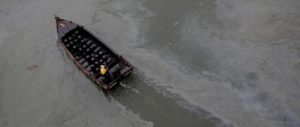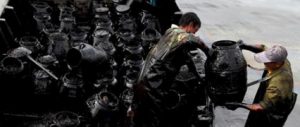By the early autumn, the Bohai Sea oil spill that began in the Penglai 19-3 oil field in June had polluted 5,500 square kilometres of ocean, inflicting grave consequences on marine ecology and the local fishing industry. While the leak is now said to be under control, it has ended up being a disaster of a vastly different scale from the 200-square metre slick first revealed by the field’s owners, China National Offshore Oil Corporation (CNOOC) and US firm ConocoPhillips, in July. And as the oil has spread, so has the public’s attention widened: from concern about one oil leak, to fears for the ecology of the entire Bohai Sea.
The geography of the 77,000-square kilometre Bohai Sea is different from China’s other marine areas in that it is bordered on three sides by land: the Liaodong and Shandong peninsulas stretch out around it, like two arms hugging a pearl.
But the summer’s spill has cast a shadow over that pearl. In the words of Wang Shicheng, marine expert and former deputy director of the Shandong Oceanic and Fisheries Office, “pollution from oil exploration is the biggest threat to the Bohai’s marine environment.”
A sedimentary basin with rich oil and gas deposits, the Bohai became China’s second largest oil-producing region when the Shengli, Dagang and Liaohe fields came on stream in the second half of the twentieth century. It now accounts for half of all of China’s offshore oil and gas output. As of the end of 2009, 165 oil platforms were in operation here, spread among 20 different oil fields.
But that spectacular development has brought with it huge risks, all too clear from a scan of the State Oceanic Administration’s (SOA) Bohai management plan, which provides a list of disasters: “In 1979, as much as 45,708 tonnes of crude oil were discharged into the Bohai from the Shengli oil field; in 1987, some 1,470 tonnes of crude oil leaked from the Qinhuangdao oil terminal; in 1986, large quantities of crude oil leaked from the Bohai No. 2 platform blowout; in 1990, an oil leak covered 120-square kilometres after a collision between Panamanian and Libyan freighters in the Laotieshan Channel, leading to a 1,000-square kilometre red tide four days later; at the end of 1998, a collapsed well structure at the Shengli oil field leaked for six months.” And so it continues.
Meanwhile, SOA figures show that the Bohai was hit by 16 oil leaks during the 10th Five-Year Plan period (2001 to 2005), accounting for almost half of all oil leaks in Chinese waters. And, during the 11th Five-Year Plan period (2006 to 2010), the risk of offshore oil leaks “continued to rise”. In 2008 alone, there were 12 small leaks in the Bohai, more than in the South China Sea or the East China Sea.
It is not just oil wells that can cause pollution, explained Wang Shicheng – there is also a risk of pollution from shipping and factory ships. “Exposure to oil can cause developmental abnormalities in the juveniles of many marine animals, and when a weak link in the marine ecosystem is damaged it can take decades to recover.”
The risks of the oil industry offshore are matched by those posed by the chemical industry onshore. Cities and provinces around the Bohai Sea have put these two sectors at the heart of their economic development.
In 2004, then mayor of the city of Dalian Xia Deren said he would give priority to development of the petrochemical industry. And Liaoning province as a whole is making the sector a major part of its economic push. Shandong province and the city of Tianjin also stress the significant role of the petrochemical industry in their financial development.
It is hard to calculate exactly how many chemical firms there are on the Bohai coast, but there are 38 in the Dagushan Chemical Industry Zone in Dalian alone, which is only 5.84 square kilometres in size and lies right on the coast. It is also the site of the Dalian PX factory ordered to relocate after an August storm washed away a dyke protecting the facility, triggering large-scale protests.
Building petrochemical facilities by the coast increases the risks of polluting the sea with industrial wastewater. In 2007, of 180 firms chosen for waste-water monitoring in the 13 Bohai coastal cities with more than one million inhabitants, 41 were found to be in breach of standards – and 35 (85%) of these were major polluters such as petrochemical, paper-making or printing and dyeing firms.
Land reclamation is also putting pressure on the Bohai. Between 1996 and 2007, some 551 square kilometres of land was reclaimed from the sea, while shoals and coastal wetlands were reduced by 718 square kilometres – an average decline of 1% a year. This is equivalent to reducing the ability of the Bohai coast to absorb pollution by 2% to 10% annually.
Land-reclamation projects have become more frequent and larger in scale in the last three years. Tangshan Caofeidian Industrial Zone is to use 310 square kilometres of ocean, 240 square kilometres of which will be filled in and reclaimed. In total, 1,000 square kilometres of land reclamation is planned for Liaoning’s six coastal cities.
In 2007, an SOA document said that “artificial islands [and peninsulas], particularly those connected to the mainland, will change water flow in the area, marine life, water circulation and the shape of the seabed. Creating too many artificial islands could have disastrous consequences for the marine environment. “
Wang Shicheng said: “The fact that the Bohai is enclosed on three sides means that water here is replaced slowly, and pollution doesn’t get flushed out. Experts have calculated that it takes 30 years or more for all the water in the Bohai to be replaced.”
With an “oceanic great leap forward” under way on the coasts of the Bohai Gulf, wetlands have been damaged and the water quality in the Bohai has been steadily worsening.
A document obtained by Time Weekly called “Overall Plan for Environmental Protection of the Bohai Sea”, jointly produced by a group of government departments with input from oil companies and local authorities, indicates that, during the 10th Five-Year Plan period, the area of the Bohai affected by pollution fluctuated between 19,000 and 32,000 square kilometres – between 24% and 41% of the total area. In 2005, more than 20,000 square kilometres (26%) failed to meet the standard for “clean water”. Of this, 9,000-square kilometres were classed as “relatively clean”, 6,000 as “lightly polluted”, 3,600 as “heavily polluted” and 2,000 as “extremely polluted”. Monitoring exercises in near-coastal waters further indicated that, between 2006 and 2010, the area of water considered “heavily polluted” grew three-fold.
Worsening water quality has had a direct impact on the fishing industry. The deep waters at the centre of the Bohai are breeding and wintering grounds for fish, shrimp and crab and the area has historically been known for its rich and fertile fishing stocks.
Historical data shows that the Bohai used to be home to 150 aquatic species, including 70 that were fished commercially. According to the Economy and Nation Weekly, unpublished figures from the SOA show that, in the decade from 1982, the number of commercial species in the Bohai Gulf and Liaodong Bay dropped from 85 to 74. By 2004, the figure had fallen to 30.
In July this year, a report from Tianjin Bohai Aquatic Products Institute indicated that the number of species with significant commercial value had fallen from 70 to 10. There was almost no trace of the ribbonfish, Chinese herring, red porgy, lefteye pounder or pufferfish.
Another highly visible consequence of sea pollution is the emergence of red tides, or algal blooms, where excessive nutrients trigger a sudden explosion in the quantity of toxic plankton. According to data from the National Marine Environment Monitoring Centre, 80 red tides were recorded in the Bohai between 2000 and 2006, totalling 19,800 square kilometres in area, and the frequency and scale of red tides has increased by 4.2 times and 1.6 times respectively since the 1990s. In mid-July this year, a huge red tide, two nautical miles long, appeared at the site of the oil leak.
Meanwhile, just last week, the SOA initiated a level-three emergency response after another oil spill was spotted in Liaodong Bay’s Jinzhou 9-3 oilfield, believed to have been caused by ship anchors rupturing an underwater pipe. For the fish and shellfish of the Bohai Sea, it seems there is no escape.
Wu Xiaolei is a reporter at Time Weekly, where this article was first published.
Image by Lu Guang/Greenpeace shows a fisherman after the Dalian oil spill.





